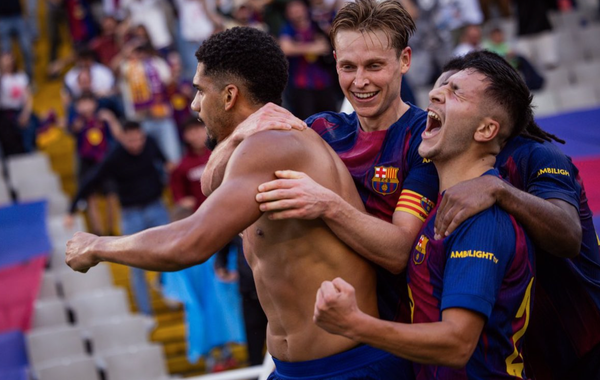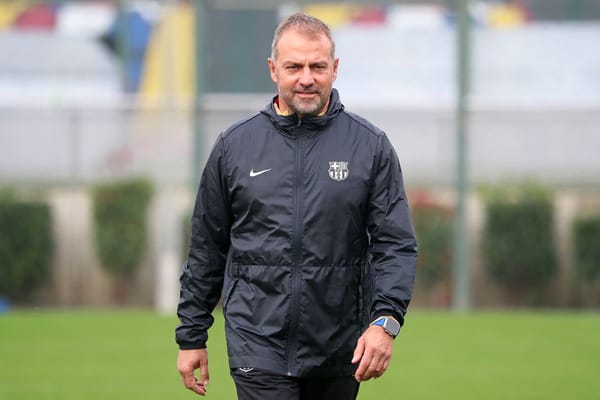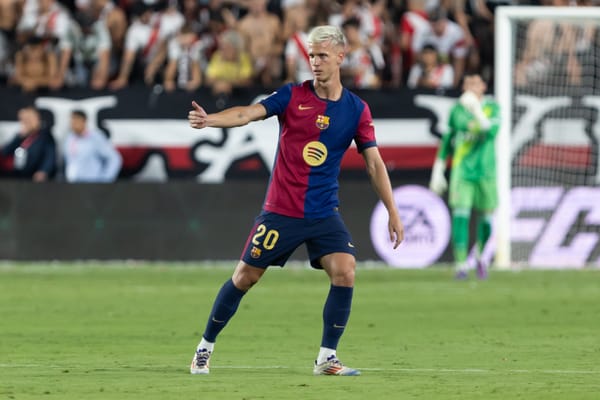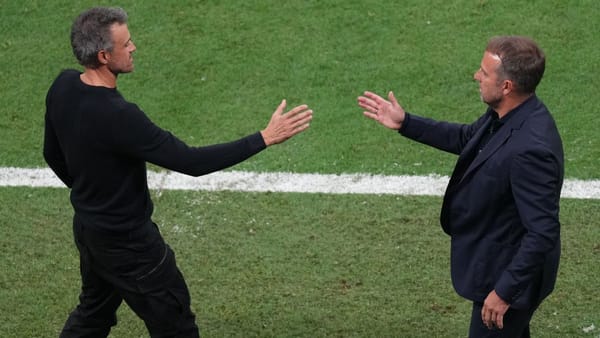Are Barcelona naive?
Some believe Hansi Flick’s out-of-possession approach is naive. Is it true? Are Barcelona naive?
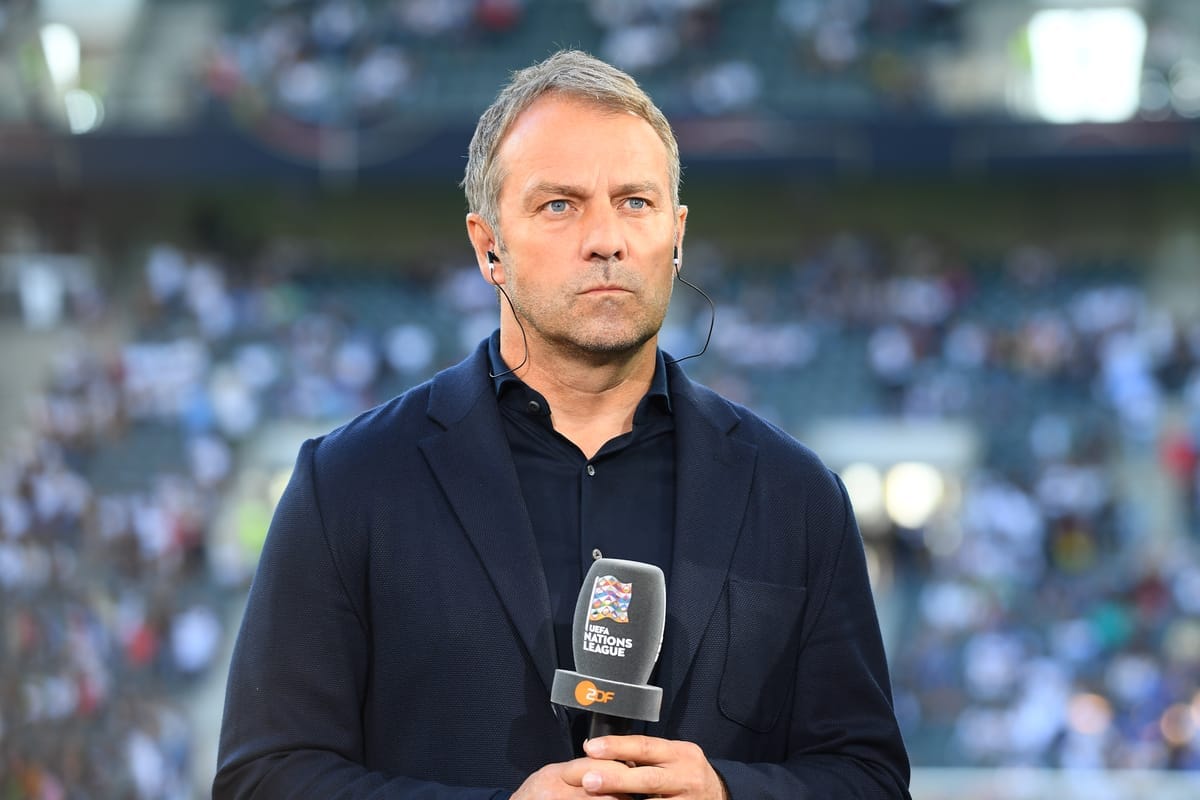
This is BarcaFutbol's guest piece, written by the talented @AM10FCB. Make sure to follow his work on X, where he regularly posts opinions and analysis of FC Barcelona and more.
In case you want additional long-form content of this kind from him, check out his blog HERE.
BarcaFutbol thanks AM for taking the time to write this great piece of tactical analysis for our site and hopes to see him feature again at some point in the future.
Happy reading, Cules.
Some time back, Barcelona faced Atletico Madrid in the Copa Del Rey Semi-finals, which ended in a disappointing 4-4 draw. The reason it's disappointing is common sense to any fan who watched the match; Barcelona were leading 4-2 until they completely dropped their intensity and subbed off some key players, ultimately allowing Atletico Madrid to score two goals in quick succession towards the end of the match, equalling the scoreline. Frustrating, albeit somewhat self-inflicted, too.
In any case, it has added fuel to the discourse that claims Flick’s out-of-possession approach is naive. But is it valid to denounce his whole out-of-possession approach in such a manner?
First of all, there is some missing context. A coach of Flick’s stature and experience doesn’t implement a system without some level of consideration–calling it naive is reductive. It has its drawbacks, sure, but the vital factor one misses while discussing this is that it has its benefits in Flick’s eyes, and that’s why he trusts this system and these principles.
This article aims to understand those benefits, whether they outweigh the risks/drawbacks, and whether Barcelona should alter their current out-of-possession system.
Understanding The System — Pros and Cons
Barcelona’s press is a 4-2-2-2 structurally, but their out-of-possession structure cannot be looked at in isolation–it’s interconnected. The 4-2-2-2 is man-to-man in nature, with two forwards (Raphinha and Lamine Yamal or Robert Lewandowski) on the opposition centre-backs while Pedri/Lewandowski and Dani Olmo are on the pivots. It’s not a direct implementation, though.
Yamal starts wider on the full-back and then moves onto the centre-back once there’s a wide pass into one of those central defenders. At that moment, Barcelona's full-back, Jules Kounde in our example, will spring up to mark the full-back—and the same happens on the other side with Raphinha and Balde, respectively.
They use the forward on the centre-back to ensure the ball is moved down one side without a switch and then the full-back moves forward to pressure his counterpart. It's a domino effect as this then pushes Barcelona's own centre-back wide to press the opposition winger while the pivot, often Frenkie de Jong or Marc Casado, drops to cover for his defender's movement.
Here, Raphinha presses the CB to ensure the ball is played down the left flank while Yamal and Lewandowski are covering for the far-side CB/FB in case of a switch. Balde, on the other hand, presses the opposition FB up ahead, and Inigo presses the opposition winger while Frenkie drops down in case Inigo gets beaten. Quite clearly, there is a firm system in place here.
Barcelona also play a very high line aiming to catch the opponent offside, but here’s the point a lot of people seem to miss out on—it’s not that risky overall. When Barcelona play such a high line with high pressure on the ball, they’re essentially compressing the middle, reducing space and reducing time with pressure. It might seem like long-balls and quick switches are effective strategies but they’re not consistent.
You rarely see sustained chance creation through long-balls from back to front and teams rarely get the space and time to hit long switches anymore unless Barcelona are fatigued. Even then, the fatigue seems to have reduced due to a massive improvement in retention and overall possession game of the team. Barcelona are forcing teams to make spontaneous and direct decisions without letting them strategise or develop any kind of mechanism to score against them consistently, exactly due to high pressure and the high line. When that’s combined with their efficiency in offside traps, you get a team that seems vulnerable but is actually pretty compact.
However, the high line and the offside trap are Flick’s trademark out-of-possession principles and it’s gotten him the most criticism among fans and analysts. Here’s why: It’s exploitable through deep runs. The high line adjusts itself according to the last men in the opposition's attacking line. Essentially, the line tries to position itself higher than the last man to put them in an offside position.
But, when an unexpected run is made from deep, the high line fails to anticipate it and often gets beaten. Why? Well, because it's based on the last man and fails to account for the deeper players who will have a dynamic advantage in reaching the ball.
This system is also exploitable through wing-to-wing switches of play. When the ball is out wide, the team shuffles together to that wing and the FB will be on the line of the winger according to which the striker can adjust his position. A complete wing-wing switch will lead to the entire team shuffling across in a short time, leaving gaps in the middle and not allowing them to reorganise the high line well. This then allows the opposition team to beat the offside trap.
For example, the goal Bayern scored against Barcelona. It was a direct switch from Michael Olise because there was no pressure. Gnabry then gets the ball, the high line is shuffling, Kane is onside and he scores. Simple, no?
Well, yeah but football is rarely just black or white; there are solutions to these problems and there are problems to these solutions. Sounds a bit uncanny, granted.
The solution to these problems is pressure on the ball. Once again, it sounds very basic, but that’s the reality. A wing-wing switch is not feasible due to the length of the pass and the time you need to play it, which is why pressure on the ball can prevent that switch from being played 9 out of 10 times. And how does more pressure solve the first problem? In the picture attached, Kimmich is not even being pressed up front, which gives him enough space and time to play a well-calculated ball in behind.
If there was pressure on the ball, it wouldn’t allow a pass from behind to be played in so easily unless it’s from the first line of defence, which would be winnable aerially and not a reliable method of breaking teams down every single time. Once again, pressure on the ball makes these teams profoundly confused on how to beat this team. It can also be an issue if Barcelona's counter-pressing isn’t intense enough; players are in close proximity a lot of the time but meek intensity in the counter-press can lead to vulnerability in transitional defending. That’s been an issue against Atletico Madrid, too.
Now, the part where there are problems to this solution is, again, basic—running. Running at high intensity throughout 90 minutes is unrealistic, unsustainable and extremely draining. It leads to fatigue (that will affect the in-possession performance) and increases the risk of injury. For reference, Barcelona’s running distance per match is 116km, 13km more than the league’s average.
"If you're attacking, you don't get as tired as when you're chasing." - Kyle Rote, Jr.
The solution to this? Once again, it’s about balance. Balance doesn’t have to mean reducing our level of intensity but the frequency of it. There’s an absolute necessity for the team to reduce the amount of running they do. Now, that can be done in two ways—either by fielding a mid-block during certain periods or by retaining the ball completely for certain periods.
Either works.
Final remarks
More often than not, however, teams that conserve energy mid-game use both of these strategies rather than just one of them. Arsenal are a great example of maybe the best defensive team in Europe. Barcelona do adopt these strategies but there’s a real question on its effectiveness. At times, at least.
Firstly, regarding the issue of retention—Barcelona had issues with retaining the ball previously but they've gotten much better during winning game-states as of late. And that’s been a conscious improvement the team has made, which is definitely going to help conserve energy. However, it is very tough to switch gears mid-game for a team like Barcelona due to how fluid and quick they are through all the phases. But there’s been a conscious effort from the coaching team and players to implement retention in the winning game-states and it seems like it’ll only get better as time passes.
However, the mid-block is a matter of concern. Flick-ball’s non-negotiable is the immense high-line and offside trap, no matter the circumstances. The mid-block is compact but it does leave the opponent team with space ahead and behind; you’re giving them the leverage to attack that space. With less space between their players, it’s easier for them to engage in switches that threaten the backline infinitely more due to the reduced distances.
Unless the team can adjust the height of its defensive line according to the first line of press and the intensity of the first line, the team will have this flaw that could haunt them. There’s also a lack of flexibility in this particular facet that’s not ideal for them. Recently, though, there have been instances when Barcelona have adjusted their height in certain game-states, which indicates improvement.
More than the tactical side of it, it shows more positives about how Flick’s open and willing to tweak what’s not working. And regardless, his adaptability this season has been very nice—he’s handled the rest-defence well with the concept of far-side full-backs being cautious with their positioning.
This image depicts how Barcelona’s defensive line has dropped deep when necessary, showing Flick’s flexibility when needed and Barcelona’s continuous improvement throughout the season. Overall, Flick’s approach is largely coherent, out of possession included. Most of the unprecedented criticism stems from a lack of understanding regarding the correlation between the philosophy on and off the ball.
When you observe it as a part of the larger picture, it’s a system that’s effective and has its overwhelming merits. The one primary criticism I projected towards the end doesn’t seem like something that might change entirely but it’s something that Flick considers a risk worth taking. Of course, the evaluation of risk vs reward ultimately differs from person to person. Either way, it’s safe to say it has been working.
Flick showed progress this season and that’s the most important, not in terms of results but in terms of an identity, a culture, a distinct style based on expression and showcasing the technical proficiency and understanding of the players while also being adaptable to tweaks and improving the team game by game.
And we have to commend him on that.

